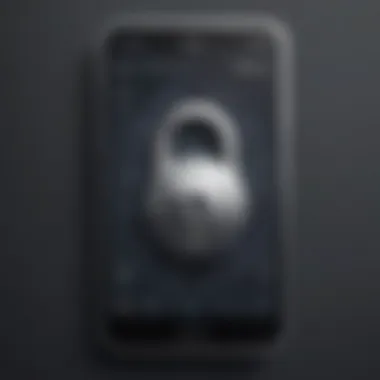Expert Guide: How to Track and Secure Your Lost Cellphone for Data Protection


Overview of Cyber Security Threats
In today's digital landscape, individuals face a myriad of cyber security threats that pose risks to the safety of their personal data. Common types of cyber threats include malware, phishing, and ransomware. Malware is malicious software designed to infiltrate devices and steal sensitive information. Phishing involves deceptive techniques to trick users into revealing confidential data. Ransomware encrypts files and demands a ransom for decryption. By understanding these threats, individuals can better protect themselves from potential cyber attacks. Statistics on cyber attacks highlight the escalating prevalence of online security breaches, serving as a wake-up call for individuals to bolster their defenses. Real-life examples of security breaches, such as data breaches at major corporations, underscore the importance of prioritizing cyber security measures.
Best Practices for Online Security
In the realm of online security, adopting best practices is essential for fortifying one's digital defenses. One fundamental aspect is the creation and management of strong passwords. Incorporating a mix of alphanumeric characters, symbols, and uppercase letters enhances password strength and mitigates the risk of unauthorized access. Regular software updates and patches are crucial to address vulnerabilities and patch security holes. Two-factor authentication adds an additional layer of protection by requiring users to provide multiple forms of verification before accessing their accounts. By adhering to these best practices, individuals can establish a robust security foundation for their digital presence.
Reviews of Security Tools
Navigating the landscape of security tools can be overwhelming, necessitating thorough evaluation to determine efficacy. Antivirus software plays a vital role in detecting and removing malware threats. Conducting a comparative analysis of firewall protection enables individuals to select the most suitable solution for safeguarding their devices against external threats. Password managers offer secure storage for login credentials, streamlining access while maintaining robust encryption protocols. By assessing the effectiveness of these security tools, individuals can make informed decisions to enhance their online security posture.
Tips for Ensuring Online Privacy
Protecting online privacy is paramount in safeguarding personal information from unauthorized access or exploitation. Utilizing Virtual Private Networks (VPNs) during browsing sessions encrypts data and masks IP addresses, enhancing anonymity and security. Configuring privacy settings on social media platforms limits the visibility of personal information to mitigate risks of data exposure. When engaging in online transactions, employing encryption protocols and securing payment gateways safeguards sensitive data from interception. By implementing these privacy measures, individuals can maintain a heightened level of confidentiality and integrity in their online interactions.
Educational Resources and Guides
Access to educational resources and guides empowers individuals to bolster their online security practices and navigate potential risks effectively. How-to articles on setting up encryption tools equip users with the knowledge to encrypt their communications and protect data transmissions. Step-by-step guides on identifying and avoiding phishing emails educate individuals on detecting common email scams and mitigating their impact. Cheat sheets featuring practical tips for enhancing online security practices offer quick reference points for implementing proactive measures. By leveraging these educational resources, individuals can stay informed, vigilant, and resilient against evolving cyber threats.
Introduction
Cellphone security is a critical aspect of our digital lives, and understanding how to find your misplaced device is paramount in ensuring the safety of our personal information. In today's tech-savvy world, where cellphones have become an indispensable tool for communication and daily tasks, the risks of losing them and compromising sensitive data have increased significantly. This comprehensive guide will delve into essential steps and strategies to locate your cellphone while prioritizing security measures to protect your device's data integrity and your online privacy.
Understanding the Importance of Cellphone Security
Cellphones play a pivotal role in modern society, serving as multifaceted tools for communication, productivity, and entertainment. The ubiquity of smartphones underscores their significance in our daily lives, acting as repositories of personal and professional information. Safeguarding personal data stored on these devices is crucial to prevent unauthorized access, identity theft, and privacy breaches. Embracing robust cellphone security measures is essential to mitigate these risks and maintain control over our digital footprint.
The role of cellphones in daily life
Cellphones have metamorphosed into indispensable companions, facilitating seamless communication, task management, and social connection. Their compact design, diverse functionality, and universal accessibility make them a preferred choice for individuals seeking efficiency and connectivity. However, this reliance on cellphones also amplifies the stakes of data security, necessitating proactive measures to fortify defenses against potential threats.
Significance of safeguarding personal information
The sensitive nature of the data stored on our cellphones, including personal details, financial information, and digital credentials, elevates the importance of securing this information. Unauthorized access to such data can lead to severe consequences, including financial loss, identity theft, and privacy infringements. By prioritizing the protection of personal information, individuals can safeguard their digital identities and minimize the impact of security breaches.
Common Scenarios of Misplacing Your Cellphone
Losing a cellphone is a distressing situation that can occur under various circumstances, such as absentmindedly leaving it in public places or unintentionally forgetting it at a friend's house. Understanding these common scenarios and adopting proactive approaches to retrieve the device are crucial steps in mitigating the potential risks associated with misplaced cellphones.
Forgetting your device in public places
Unintentionally leaving your cellphone in public settings, whether in restaurants, transportation facilities, or shopping centers, is a common occurrence that exposes the device to theft or unauthorized access. Retracing your steps, checking nearby areas, and enlisting the help of establishment personnel are recommended strategies to recover the device promptly and prevent data breaches.
Accidentally leaving it at a friend's house
Leaving your cellphone at a friend's residence can lead to both logistical challenges and security concerns. Collaborating with your friend to locate the device, remotely activating tracking features, and implementing security protocols to safeguard data confidentiality are vital steps in addressing this scenario effectively.
Immediate Steps to Take When Realizing Your Cellphone is Missing
When you discover that your cellphone is missing, it can be a distressing situation. The immediate steps you take are crucial in effectively addressing this issue and ensuring the security of your device and data. This section will guide you on the essential actions to take promptly to maximize the chances of recovering your cellphone and safeguarding your personal information.
Stay Calm and Retrace Your Steps
Check your last known locations
Checking your last known locations is a pivotal initial step when attempting to locate your missing cellphone. This feature allows you to track where your device was last active, providing valuable insights into areas you may have visited. By reviewing this data, you can narrow down possible locations where your cellphone might be, aiding in your search efforts. Whether you left it at a restaurant or on public transport, retracing your movements through this functionality enhances the probability of successfully identifying the whereabouts of your device.
Look around in nearby areas
Besides utilizing technology to track your device, it is equally important to physically survey the surrounding areas where you suspect your cellphone might be. By visually inspecting nearby locations such as your home, workplace, or frequent spots, you increase the likelihood of spotting your device. Sometimes, a simple visual scan can lead to quick retrieval. This method, combined with digital tracking, offers a comprehensive approach to locating your missing cellphone effectively.
Utilize Tracking Apps or Features


In the event that manually searching for your cellphone proves challenging, employing tracking apps or features can be instrumental in pinpointing its exact location. These applications leverage GPS technology to provide real-time location data, aiding in the swift recovery of your device.
Using 'Find My iPhone' on iOS devices
For iOS users, 'Find My iPhone' is a robust tracking feature that enables you to locate your device with precision. By logging into your iCloud account on another device, you can pinpoint the exact whereabouts of your iPhone on a map. This tool simplifies the search process, allowing you to retrieve your device quickly and efficiently.
Activating 'Find My Device' on Android phones
Android users can leverage the 'Find My Device' functionality to track their smartphones when misplaced. By activating this feature via the Google account linked to your device, you gain access to its location in real-time. This resourceful option streamlines the search process, facilitating the timely recovery of your Android phone.
Enhancing Cellphone Security Measures
In this comprehensive guide on finding your lost cellphone and securing your device, the section focusing on Enhancing Cellphone Security Measures serves as a crucial aspect of safeguarding personal data. By implementing robust security measures, individuals can mitigate the risks associated with losing their devices. One of the key elements of security enhancement is the adoption of biometric authentication and the installation of security apps.
Implementing Biometric Authentication
Setting up fingerprint or facial recognition
Setting up fingerprint or facial recognition plays a pivotal role in enhancing the security of a cellphone. This feature allows users to add an extra layer of protection by using unique biometric information for device access. The convenience and reliability of biometric authentication make it a favored choice for individuals looking to secure their devices effectively. The distinct feature of this method is its personalized approach, where only the registered user's fingerprint or facial data can unlock the device. While offering convenience, it also presents advantages like quick access and reduced reliance on traditional passcodes.
Utilizing two-factor authentication
The utilization of two-factor authentication is another vital component of enhancing cellphone security. This method involves verifying a user's identity through two different authentication factors, typically combining something the user knows (like a password) with something they have (like a verification code sent to their registered device). By adding an extra step to the authentication process, two-factor authentication significantly strengthens the security of the device. Its prominent characteristic lies in providing an additional layer of defense against unauthorized access attempts. While enhancing security, it may slightly increase the time needed for device access but presents a notable advantage in terms of heightened protection against potential breaches.
Installing Security Apps for Added Protection
Antivirus software for malware detection
The installation of antivirus software for malware detection is a fundamental measure in bolstering cellphone security. This specialized software scans the device for malicious software and promptly alerts users about any potential threats. The key characteristic of antivirus software is its ability to identify and eliminate various types of malware, including viruses, spyware, and Trojans. Its popularity stems from offering real-time protection and proactive defense against evolving cyber threats. Despite its advantages, users must be mindful of potential system resource consumption and periodic updates required for optimal security.
App locks for restricting access to sensitive data


App locks provide an added layer of security by restricting unauthorized access to sensitive data stored on the device. This feature allows users to selectively lock individual applications or content, requiring additional authentication before granting access. The key characteristic of app locks is their customization options, enabling users to tailor security settings based on their specific privacy needs. By offering enhanced control over data access, app locks are a popular choice for individuals seeking to secure confidential information effectively. While advantageous in safeguarding privacy, users should remember potential inconveniences related to frequent authentication prompts and the need to remember additional passcodes or patterns.
Informing Authorities and Preventing Data Breaches
Informing Authorities and Preventing Data Breaches play a pivotal role in safeguarding your lost or stolen cellphone and preventing potential data breaches. By promptly reporting the incident to the relevant law enforcement agencies, you not only increase the chances of recovering your device but also prevent unauthorized access to your sensitive information. This proactive step is crucial for maintaining the security and integrity of your personal data.
Reporting to Law Enforcement
Providing Necessary Details for Documentation
Providing necessary details for documentation involves sharing vital information such as the device's make and model, IMEI number, and last known location with the authorities. By providing these essential details, law enforcement can create a comprehensive report, increasing the likelihood of locating your cellphone. This meticulous documentation process is a key component in expediting the recovery process and enhancing the effectiveness of the investigation.
Cooperating with Investigations
Cooperating with investigations is vital in facilitating the search for your missing device. By actively engaging with law enforcement personnel, providing additional insights, and following up on any leads, you contribute to the swift resolution of the case. Collaboration with investigators not only aids in recovering your cellphone but also assists in apprehending potential perpetrators, ultimately leading to a more secure outcome for your device.
Securing Personal Information
Remote Wiping of Data If Retrieval Is Not Possible
In situations where the recovery of your cellphone seems unlikely, remote wiping of data is a crucial security measure to prevent unauthorized access to your personal information. By remotely erasing all data on the device, you ensure that sensitive data such as contacts, messages, and documents are not compromised. This proactive approach protects your privacy and minimizes the risk of data breaches resulting from a lost or stolen device.
Changing Passwords for Online Accounts Linked to the Device
Changing passwords for online accounts linked to the lost or stolen device is imperative to prevent unauthorized access to your confidential information. By updating passwords for accounts connected to the missing device, you mitigate the risk of unauthorized entry into your online accounts. This precautionary measure enhances the security of your digital footprint and reinforces your defense against potential malicious activities.
Conclusion
In the realm devoted to defending the safety and confidentiality of personal mobile devices, such as smartphones, concluding on a note exalting the necessity of utmost vigilance and security measures is paramount. The perils of neglecting device security can loom menacingly, prompting a reminder that diligence is the shield against potential breaches. Through this comprehensive guide on locating misplaced cellphones, the directive is clear - proactive engagement is a shield, not mere prudent advice. Every detail conveyed has a purpose that harmonizes to illuminate a path toward data protection.
Final Thoughts on Cellphone Security and Recovery
Emphasizing the importance of proactive measures
The pinnacle of cellphone security lies not only in reaction but in anticipation, engraving a perpetual shield against potential breaches. Emphasizing proactive measures underscores the core essence of defense, advocating for continuous vigilance over intermittent remedy. The dynamism in preemptive measures serves as a force multiplier in the ecosystem of data protection, converging to fortify the resilience of personal information. This approach, characterized by its anticipatory ethos, stands as the bedrock of secure mobile practices. The strategic deployment of proactive measures charts a proactive defense map that preempts breaches, conferring peace of mind and preemptive vitality to the cellphone security landscape.
Encouraging regular backups of important data
The backbone of cellphone security architecture twines intricately with the discipline of regular data backups, serving as the linchpin in fortifying against possible data loss or compromise. Encouraging the habitual act of data backups does not only resonate with prudence but also with strategic foresight, ingraining a safety net woven from meticulous preparatory threads. The cascading benefits of regular data backups unfurl beyond just data retrieval, extending to a comprehensive shield against potential data corruption or loss. This enigmatic yet simplistic practice heralds longevity and robustness to the data ecosystem, offsetting vulnerabilities with a shield forged from foresight and preparedness. By fostering a culture of data guardianship through regular backups, individuals secure their digital assets against unforeseen adversities, fostering a domain where data integrity reigns supreme.





